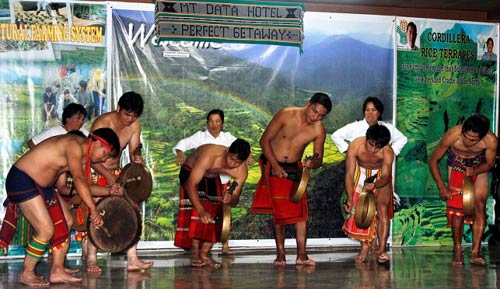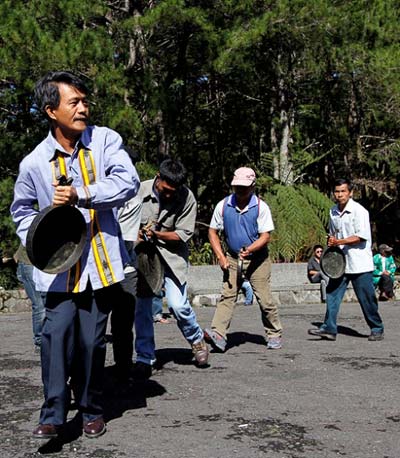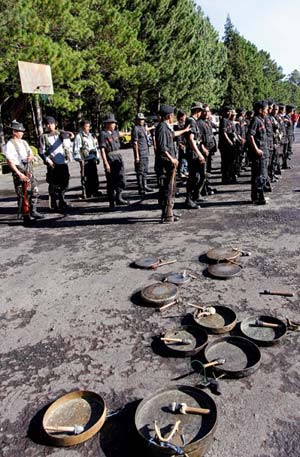Fourteen hours north from Metro Manila, and the Mountain Province greets us with the sound of gongs in the night. Welcome to the Cordilleras. Up here, at an elevation anywhere from a thousand to 7,000 feet above sea level, your breath coalesces into a cloud of its own when you exhale. As the country's only land-locked territory, the Cordillera Administrative Region (or CAR) is vast, culturally diverse and the central mountain range itself seems mostly untouched. The last isn’t only due to the fact it’s hard to get around in the rugged terrain, what with the frequency of falling rocks or the changing condition of the roads from paved to rough to completely misted in zero visibility. There's also the ever-present threat of armed conflict in these parts, which is also almost as old as the mountains.

Cordillera men and women perform a traditional dance at the Mount Data hotel, where the peace accord was signed 25 years ago. Photo by JOSER DUMBRIQUE
This is why the celebration dubbed
Inom Galigad (roughly translated as "community drinking to accept responsibility for a pact") is a benchmark that will see the region into the 21st century not with rifles, but laurels in hand. We are in Mount Data, 100 kilometers north of Baguio City, where an end to hostilities was forged in the late 1980s. As a hotbed of communist insurgency during the Marcos years, the CAR provinces became the focus of military campaigns at the time. Finally, in 1986, newly installed President Corazon Aquino paved the way for lasting peace in the mountainous region through an indigenous treaty known as “Sipat." The government exchanged “peace tokens" with the largest rebel group in the area called the Cordillera People’s Liberation Army (CPLA) to mark an end to hostilities. The Cordillera people gave the government a spear and shield, the Armed Forces of the Philippines (AFP) presented an Armalite, and a Bible and rosary came from President Cory Aquino. That pact is now popularly known as the Mount Data Peace Accord.

Sadanga Mayor Gabino Ganggangan joins fellow Cordillera menfolk in a ritual dance to celebrate the 25th anniversary of the peace accord. Photo by JOSER DUMBRIQUE
Back then, the CPLA was chaired by rebel priest Father Conrado Balweg (1944-1999), alias Ka Ambo, who split from the main force of the New People’s Army to push the agenda of autonomy. Now, 25 years later, his image as peace maker and indigenous folk hero looms large over the Inom Galigad proceedings. It’s September 13, 2011 and the music of gongs, the stomping of feet in traditional dances, and a forum around a crackling fireplace signal the start of a conclave of elders and the holders of the peace tokens. The Office of the Presidential Advisor on the Peace Process (OPAPP) gathered the groups that signed the original accord, like the CPLA and the CBA (Cordillera Bodong Administration). In true indigenous fashion, they sought the blessing and presented to the elders of the region a plan for permanent disarmament. On the same ground where the peace pact was forged 25 years ago, the groups that have undergone many changes in form and name over the years are finally going to be transformed into an economic organization. “We are all here as a way of saying that the peace process is still worth the effort, that these efforts are still alive and kicking in the communities and in our armed components. The CPLA is not a spent force," explained the group’s current Chairman Arsenio Humiding. Earlier, the CPLA and the CBA leadership signed a Memorandum of Agreement with President Benigno Aquino’s Administration last July 4 in Malacañang. Among its many provisions is the economic reintegration of CPLA members through livelihood programs, funding for the development of hinterland villages, disarmament, and the transformation of all paramilitary organizations into civilian groups.

A CPLA team stands in formation near the ritual space. The sound of gongs, not guns, may soon reverberate in the Cordillera if all sides in the conflict come together. Photo by JOSER DUMBRIQUE
“[What’s happening now] is part of what we aspired to in 1986. We gained some things since then but our last aspiration is of course autonomy. In some aspects we are closer to it," said CBA President Marcelina Bahatan. While the Cordillera elders discussed the details of the agreement that will be implemented in the next two years, the paramilitary groups are still concerned with pocket hostilities in the region. Among these are the threat of private armies, remnants of the communist insurgents that are still entrenched in the mountains, criminal elements, and dissenting voices within their ranks. The latter claim their own following and have opposed the July 4 agreement, saying disarmament as a way to peace is not the answer to conflicts in the Cordillera region. But there are others like Gabino P. Ganggangan, who was there when the “Sipat" was signed in 1986. Now the Mayor of Sadanga municipality in the Mountain Province and the Secretary General of the CPLA, he is optimistic about the future of the new agreement as a means to full regional autonomy in keeping with the spirit of the Mount Data Peace Accord. “The fact that we are doing this through indigenous ways is the guarantee that we will have to live with the results these talks produce. This is our assurance. We are continuing it because we cannot simply disregard our commitment. For us, it is taboo to break it," he said. –
YA, GMA News 





